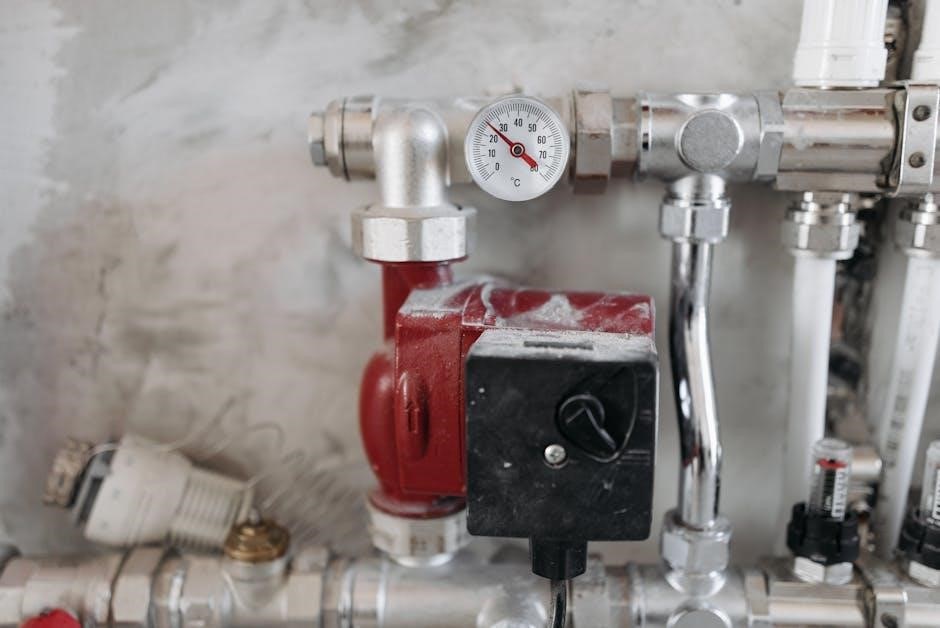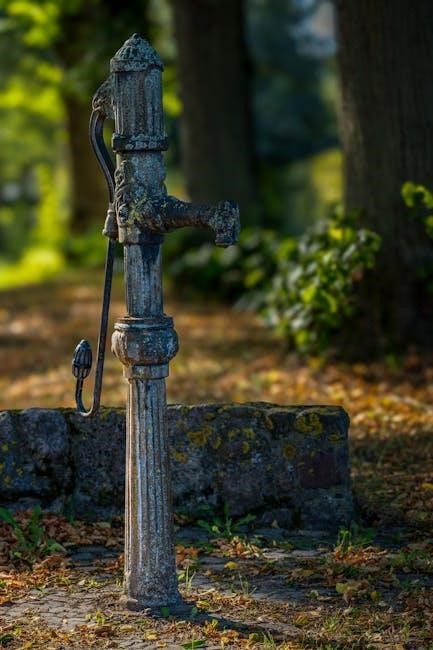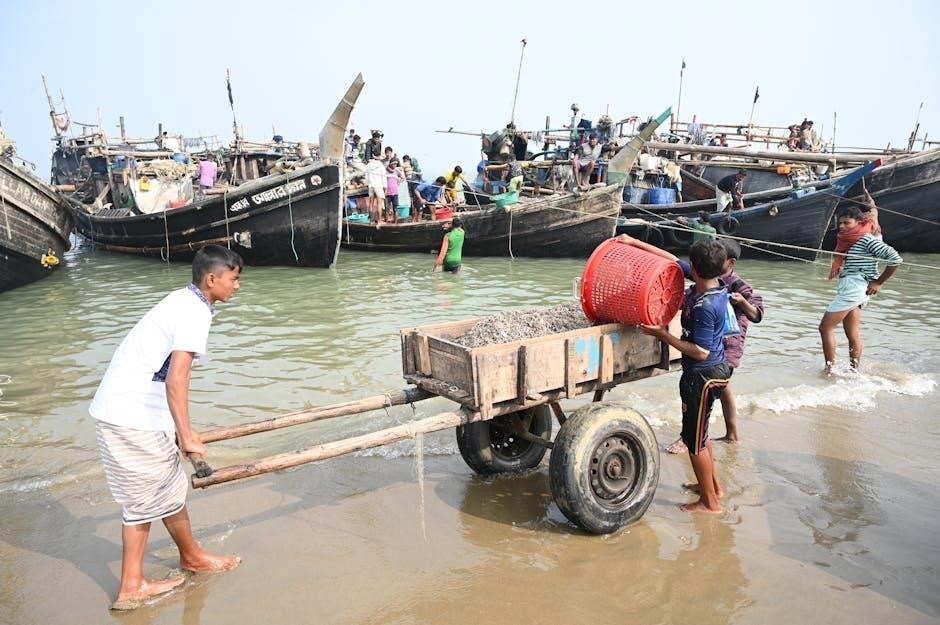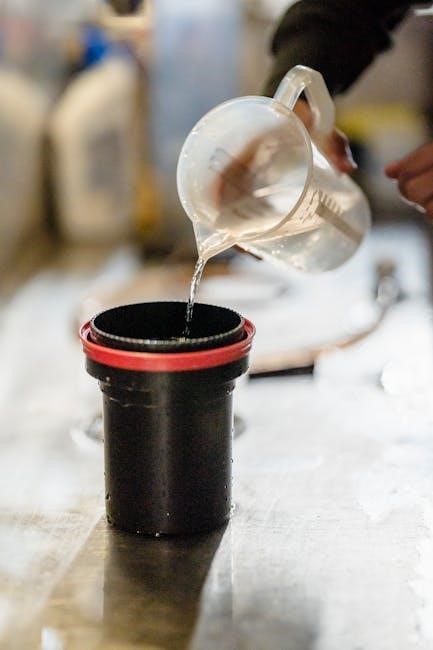A manual water pump must be fitted with pipe fittings and a pump flange gasket to maintain proper water flow and pressure in the system normally.
General Requirements for Pump Installation
The installation of a manual water pump requires careful consideration of several factors, including the type of pipe fittings and pump flange gasket used. According to the information provided, the pump flange gasket must meet the maximum height at the water line or lower, and pipe fittings are required to maintain the return 18 inches below the water level. Additionally, the pump elevation and required fittings must be referred to in the project application sections and plans. The use of specific fittings, such as 11.25 fittings, may be necessary to drop the return pipe to the desired level, in this case, 16 inches. Proper installation is crucial to ensure the pump functions correctly and efficiently. The installation process must be done in accordance with the project requirements and specifications to avoid any potential issues or damage to the pump or surrounding system.
Supporting the Pump and Pipes
Supporting the pump and pipes is crucial to ensure the manual water pump functions correctly and efficiently. The pump and pipes must be supported in a way that the weight of the pipes filled with liquid does not damage or tip the pump over. Long suction and discharge hoses or pipes must be supported to prevent damage to the pump or the surrounding system. The support system must be designed to withstand the weight and pressure of the pipes and the pump, and must be installed according to the manufacturer’s instructions and the project specifications. Proper support of the pump and pipes is essential to prevent damage and ensure the longevity of the system. The support system must be sturdy and reliable to handle the weight and pressure of the pipes and the pump. This is a critical aspect of the installation process.

Pump Installation Checklist

Organizations prepare a checklist to ensure proper pump installation and functioning normally always.
Pre-Installation Checks
To ensure a manual water pump is properly fitted, pre-installation checks are necessary, including verifying the pump’s compatibility with the system and checking for any damage or defects.
The pump’s operating manual should be consulted to determine the required fittings and accessories, such as pipe fittings and a pump flange gasket.
Additionally, the installation location should be evaluated to ensure it is suitable for the pump and meets the necessary safety standards.
The pump’s performance requirements, such as flow rate and pressure, should also be considered to ensure the pump is capable of meeting the system’s demands.
By conducting these pre-installation checks, issues can be identified and addressed before the pump is installed, reducing the risk of problems and ensuring a successful installation.
Proper planning and preparation are essential for a successful manual water pump installation.
Installing the Pump and Pipes
When installing the pump and pipes, it is essential to follow the manufacturer’s instructions and take necessary precautions to avoid damage.
The pump should be installed in a location that allows for easy access and maintenance, and the pipes should be properly sized and configured to ensure efficient water flow.
The use of teflon sealing tape on threaded fittings is recommended to prevent leaks and ensure a secure connection.
Supporting the discharge pipe is also crucial to prevent the pump from taking the weight of the pipe, which can cause damage or lead to premature wear.
Proper installation of the pump and pipes is critical to ensure the system functions correctly and safely, and to prevent potential issues such as leaks or pump failure.
Correct installation will also help to extend the lifespan of the pump and pipes, reducing the need for costly repairs or replacements.

Winterizing the Pump System
Drain the system to protect against freeze damage and prevent plumbing issues normally always.
Protecting Against Freeze Damage

To prevent damage from freezing, it is essential to completely drain the system, including the pump and pipes, to ensure that no water remains that can freeze and cause damage. This can be achieved by opening the drain valves and allowing the water to flow out. Additionally, it is recommended to use insulation or heat tape to keep the pipes and pump warm, especially in areas where the temperature is expected to drop below freezing. By taking these precautions, you can protect your manual water pump and piping system from freeze damage and ensure that it continues to function properly when needed. Proper winterization is crucial to extend the lifespan of the pump and prevent costly repairs. Regular maintenance and inspections can also help identify potential issues before they become major problems.
Additional Installation Considerations
When installing a manual water pump, there are several additional considerations to keep in mind to ensure proper function and longevity. The pump and pipes must be supported to prevent damage from weight and stress. The use of teflon sealing tape on threaded famine fittings is also recommended to prevent leaks. Furthermore, the pump should be installed with a foot valve and check valve to prevent backflow and ensure smooth operation. The pipe diameter and straight run requirements should also be taken into account to minimize friction and pressure drops. By considering these factors, you can ensure a successful installation and optimal performance of your manual water pump. Proper installation is crucial to prevent damage and ensure the pump operates efficiently and effectively, providing reliable service over its lifespan with minimal maintenance.
A manual water pump should be fitted with proper fittings and pipes for optimal function normally always.
Final Installation Checks
During the final installation checks, it is essential to verify that the manual water pump is properly fitted with all necessary components, including pipe fittings and a pump flange gasket. The pump should be installed in a vertical position, with the pump flange gasket meeting the maximum height at the water line or lower. Additionally, the return pipe should be dropped to 16 inches below the water level using 11.25 fittings. The discharge pipe should be supported to prevent the pump from taking the weight of the pipe. A foot valve and check valve should also be installed to prevent backflow and ensure proper water flow. By following these steps, the manual water pump can be installed correctly and function optimally, providing a reliable source of water. The installation should be done carefully to avoid any damage to the pump or pipes.
Post-Installation Testing
After the manual water pump is installed, post-installation testing is crucial to ensure it functions correctly. The pump should be tested for proper water flow and pressure. The test should include checking for leaks in the pipe fittings and pump flange gasket. The pump’s performance should be evaluated under various conditions, including different water levels and flow rates. The testing process should also involve checking the foot valve and check valve to ensure they are functioning properly. By conducting thorough post-installation testing, any issues with the pump or installation can be identified and addressed promptly. This helps to prevent future problems and ensures the manual water pump operates efficiently and reliably. The testing process is an essential step in the installation process and should not be overlooked. Proper testing helps to extend the lifespan of the pump.
